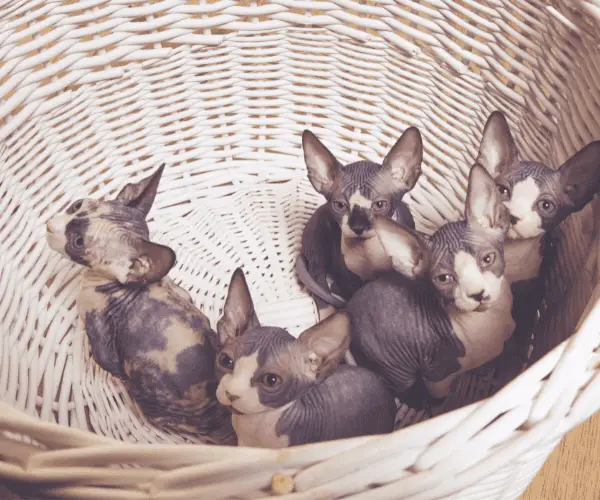
Will cross-breeding a Sphynx cat to a furry cat breed result in hairless or furry-coated kittens? This article will simplify the complicated genetics of hairless cats to answer this question. In short: yes, your pure-bred Sphynx queen can give birth to kittens with fur if the other parent is a furry breed.
If a Sphynx cat is bred to a furry cat that is heterozygous for the recessive hairless gene, approximately half of the offspring will be hairless. If a Sphynx cat is bred to a furry cat that is homozygous for the dominant hairy gene, all the offspring will be furry coated; however, breeding the offspring of the aforementioned cross with a sphynx will again result in 50% hairless offspring.
This is not to say that a Sphynx queen will give birth to a furry kitten (or more) if bred with a tom cat that is a breed with hair. Nor is it to say that a Sphynx queen will give birth to only hairless kittens if bred with a furry tom. This matter, as expected, has variable outcomes and depends primarily on the complicated (or simple – depending on how you find it) topic of genetics.
This may all sound very complicated but hang in there. It will all make sense by the end of this article! First, we need to start by explaining the basics of the genes for the hairless trait.
Why Is A Sphynx Hairless?
At the fundamental core of all animals’ (and humans’) unique characteristics is, of course, the genetic code that comprises DNA. We all know that within this coding, there is a certain level of variation which makes each living thing on this planet different from other species and also different within species.
Sphynx cats are a well-known genetic marvel within the domestic felines and an interesting display of Mendelian Inheritance with regards to genetic principles. How is it that they are mammals with no hair?

Origins Of The Sphynx Cat
The first hairless kitten was documented in Toronto, Canada, in 1966, being one of a litter born to two domestic short-hair cats, and so it was originally known as the Canadian Hairless breed (Murphy, 2022). Over the years, the hairless trait was selected for by breeding such cats with other furry breeds in the hope of getting naked kittens and then breeding hairless with hairless.
These hairless cats were also, at a time, bred with the Devon Rex, a breed of cat that has sparse curly hair. This was done in order to increase the number of hairless kittens born in order to develop the Sphynx breed. Today, the Sphynx is a renowned anomalous naked pet that is growing in popularity.
For simplicity’s sake, we will not dive into explaining how the Devon Rex’s genetics aided the development of a hairless cat breed, but if you find this interesting, have a look at the article by Gandolfi et al. (2010) to learn more.

Let’s Talk About The Basic Genetics
Early on, it was identified that the genetic inheritance of the hairless feature is in the form of an autosomal recessive gene given the symbol h (Robinson, 1973). Autosomal means that the gene is found in the chromosomes other than the gender-determining chromosomes, and therefore, the trait does not have any predilection for males more than females or vice versa. Recessive meaning that the trait is only expressed in the phenotype (external appearance) if there is no dominant partner present at the specific locus on a chromosome.
According to the National Human Genome Research Institute, the definition of a single nucleotide polymorphism (SNP) is a genomic variant at a single base position in the DNA (Gunter, 2022). This SNP creates a variation which is referred to as an allele. Put simply, alleles are different forms of a gene at a locus on a chromosome and are the determinants of distinction & dissimilarity between organisms in a species.
The naked trait of Sphynx cats is due to an SNP at the Keratin 71 gene (KRT71). Most Sphynx cats are either homozygous for the hr allele at the Hairless (H) locus, or compound heterozygotes with the re allele at the Rex (R) locus for the Devon-Rex curly hair, indicating that these are allelic and that the Sphynx allele is dominant. The Sphynx mutation results in hair still being produced, but it falls out very easily due to the bulb being poorly formed (Gandolfi et al., 2010).
Pet Vet Tip: To read more about the specifics of Sphynx skin and how to care for this special breed’s skin, have a look at the article on the skin conditions of Sphynx cats.
What Happens If You Breed A Sphynx Cat To A Furry Cat?
Let us play with some genetics. We will ignore the role of them Rex locus (from the Devon Rex breed) for now to keep it simple. Remember that a kitten, like all DNA-possessing creatures, receives one allele from its mother & one allele from its father.
- hr denotes the recessive, hairless allele that codes for a lack of hair.
- Hr denotes the dominant allele that codes for hair. If this allele is present, even if there is only one, the dominance dictates that the cat will have fur.
Refer to table 1 to see how the composition of alleles at the H locus determines the physical appearance of the cat.
Table 1:
| Genotype | Phenotype |
| hrhr | Hairless |
| Hrhr | Hair |
| HrHr | Hair |
In order to understand the inheritance of the hairless trait, have a look at the following examples demonstrating the outcome of breeding Sphynx cats with a furry breed or another Sphynx.
Example 1: A Sphynx cat with the genotype hrhr is crossed with a domestic shorthair with the genotype HrHr.
| Hr | Hr | |
| hr | hrHr | hrHr |
| hr | hrHr | hrHr |
All offspring, in this case, have the genotype Hrhr, which means they will have the dominant gene to code for hair and will, thus, all be furry kittens.
Example 2: Sphynx cat with the genotype hrhr is crossed with a domestic shorthair with the genotype Hrhr.
| Hr | hr | |
| hr | hrHr | hrhr |
| hr | hrHr | hrhr |
50% of the offspring, in this case, will be Hrhr, meaning they will have hair, and 50% will have the genotype hrhr resulting in hairless (Sphynx) kittens.
Example 3: Two Sphynx cats with the genotype hrhr are crossed.
| hr | hr | |
| hr | hrhr | hrhr |
| hr | hrhr | hrhr |
In this pure-bred match, all kittens will be hairless & therefore, Sphynx cats since there is no dominant allele (Hr) present at all.
From the above examples, it is evident that a Sphynx queen can indeed give birth to kittens with fur if the tom cat is a furry breed. Since the furry gene is dominant, even if the tom cat has only one Hr allele, the offspring will still have a 50% chance of being furry. Therefore, if you breed your Sphynx queen to a male with fur, theoretically, at least 50% of the offspring would be furry.
Practically a queen does not give birth to enough offspring in one litter for you to reliably see a 50% split each time, and, as with all things biological, you may not see a single furry kitten in the litter, or you may only see a furry kitten in the litter! Nevertheless, this remains the simplified answer to the question that a Sphynx can produce offspring with hair.
References
- GANDOLFI, B., OUTERBRIDGE, C. A., BERESFORD, L. G., MYERS, J. A., PIMENTEL, M., ALHADDAD, H., GRAHN, J. C., GRAHN, R. A. & LYONS, L. A. 2010. The naked truth: Sphynx and Devon Rex cat breed mutations in KRT71. Mammalian Genome, 21, 509-515.
- GUNTER, C. 2022. National Human Genome Research Institute, Single Nucleotide Polymorphisms
- MURPHY, L. 2022. Sphynx: Cat Breed Profile, Characteristics & Care
- ROBINSON, R. O. Y. 1973. The Canadian hairless or Sphinx cat. Journal of Heredity, 64, 47-49.

